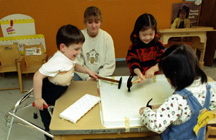 Purdue News
Purdue News
 Purdue News
Purdue News
 That's the question behind ongoing research by Karen E. Diamond, associate professor of child development and family studies at Purdue University. She also directs Purdue's Child Development Labs, a preschool program that includes children with disabilities. In its 70th year of operation, it was among the first 10 university-affiliated preschool programs in this country.
That's the question behind ongoing research by Karen E. Diamond, associate professor of child development and family studies at Purdue University. She also directs Purdue's Child Development Labs, a preschool program that includes children with disabilities. In its 70th year of operation, it was among the first 10 university-affiliated preschool programs in this country.
"Parents and teachers have intuitively believed that typical children would become more aware and sensitive to disabilities and the needs of others if they were involved with children who had disabilities," Diamond says. "But we really didn't know to what extent the children were affected - particularly preschool-age kids - until we started asking them."
The preschool years may be the most fruitful for teaching children about disabilities, she says. "You don't see the teasing of other children and overt meanness that can be displayed by older kids. Also, preschoolers are open and curious. They ask a lot of questions. They also like to test and learn about the equipment that's associated with disabilities - such as walkers and computer aids," Diamond says.
It's known that by the third or fourth grade, many children have acquired negative attitudes about people with disabilities. "Children are like all people, we choose to associate with those most like us. But in our studies of preschoolers, we see that they do accept the disabilities of others," Diamond says.
She found that youngsters, from at least age 4, are aware of disabilities in other children. "Disabilities associated with adaptive equipment, for example leg braces and hearing aids, are obviously easier for young children to notice," she says. "But our data point to the fact that young children can pick up on less obvious cues, such as developmental delays in cognition, language and physical abilities."
But there's a difference between noticing these differences and understanding why they occur. "In one study, several children referred to a peer's hearing aids or auditory trainer as the cause of his hearing loss. These children appeared to believe that the equipment interfered with - rather than aided - the child's hearing," Diamond says.
Her latest findings support the belief that preschoolers who know peers with disabilities are more accepting of other children with disabilities. In a study of 45 children ages 3 to 6 years who were in a preschool program with youngsters with disabilities, Diamond found the majority of them were likely to suggest that they could "be friends" with a hypothetical child in a wheelchair. "These kids' acceptance ratings of children with disabilities were significantly higher than those of preschool children in regular classes," she says. The study will appear in the winter 1996 edition of the journal Topics in Early Childhood Special Education.
As to whether a child chooses to play with a child with a disability, Diamond says that depends on other factors. "For example, if they are outside it may be difficult to include a child in a wheelchair in a game requiring a lot of movement. On the other hand, the disability doesn't pose a problem for some indoor activities such as building with blocks," she says. "Also, individual personalities come into play. Children may befriend a child with a disability because he's kind and cheerful."
It also may be easier for the typical preschooler to relate to a child with a disability. "All young children - whether disabled or not - need the help of others at some time. In a sense all children are handicapped in an adult world," she says. "With that in mind, early childhood programs that emphasize the contributions of each class member and that focus on ways in which all children are alike and different provide a positive learning experience for all."
baf/diamond/9604f1
NOTE TO JOURNALISTS: A color photo of a preschool child in a walker playing with his classmates is available from Purdue News Service, (765) 494-2096. Ask for the photo called Preschoolers/Diamond or download here.
Source: Karen E. Diamond, (765) 494-2958; home: (765) 497-7616; Internet: karen.e.diamond.1@purdue.edu
Writer: Beth Forbes, (765) 494-9723; home: (765) 474-3741; Internet: beth_forbes@purdue.edu